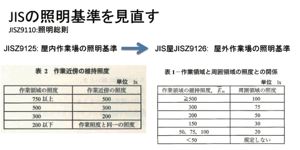|
2012/02/-- |
Illuminance Criteria After the Fukushima Nuclear Accident

Turning off the light was the most popular and poor energy-saving measure implemented after the accident at the Fukushima nuclear power plant, which turned out to be a social experiment of “light down” since the oil shock. Many people should have realized how much unnecessary light had been used, as they found no trouble without light on trains and in train stations in the daytime.
On April 14, 2011, The Ministry of Economy, Trade and Industry published a notification to revise the form of “General rules of recommended lighting levels (JIS Z9110: 2010).” It stated the emergency countermeasures responding to the energy saving need after the Fukushima nuclear accident: to provide ranges for the illuminance criteria and to lower the overall recommended illuminances by adopting the lower limit equivalent to approximately two-thirds of the existing criteria. Thus, for the outdoor spaces, 3 lux for residential district was revised to 2 lux, 5 lux for pedestrian road to 3 lux, and 20 lux for 40km/h vehicular traffic road to 15 lux.
While there was a lot of positive feedback on less illuminated outdoor spaces in nighttime urban areas, partial lighting operations created a dismal atmospheres in some interior spaces. It is reported that many companies are planning to turn off all fluorescent lamps on the ceilings and to provide LED desk lights in order to achieve energy saving of 90%. It is easy to assume that this measure would result in a stressful working environment since the ceilings and the walls would be too dark compared to the working plane.
My suggestion is, therefore, revising the illuminance criteria. Instead of “the average illuminance” of the entire space, “task and ambient illuminance ratio” stated in “Lighting of outdoor work places (JIS Z 9126:2010 4.3.3) ” should be applied to interior illuminance criteria. For example, recommended illuminance for office is now 500-750 lux in average. If we apply the “task and ambient illuminance ratio,” the illuminance target would be 750 lux for the task plane and 100 lux for the entire room. It will bring about a high energy-saving effect and simultaneously create a comfortable environment.
Effective energy-saving measures are required as the emergency energy-saving countermeasures are likely to be prolonged. Light source considerations, lighting circuit planning, non-glare fixtures usage, daylight usage, and daylight-integrated controls are inevitable. In addition, it is necessary to make bold changes in the illuminance criteria to ensure comfortable lighting environment for workers’ mental health.
Lighting Designer, Reiko Chikada
|